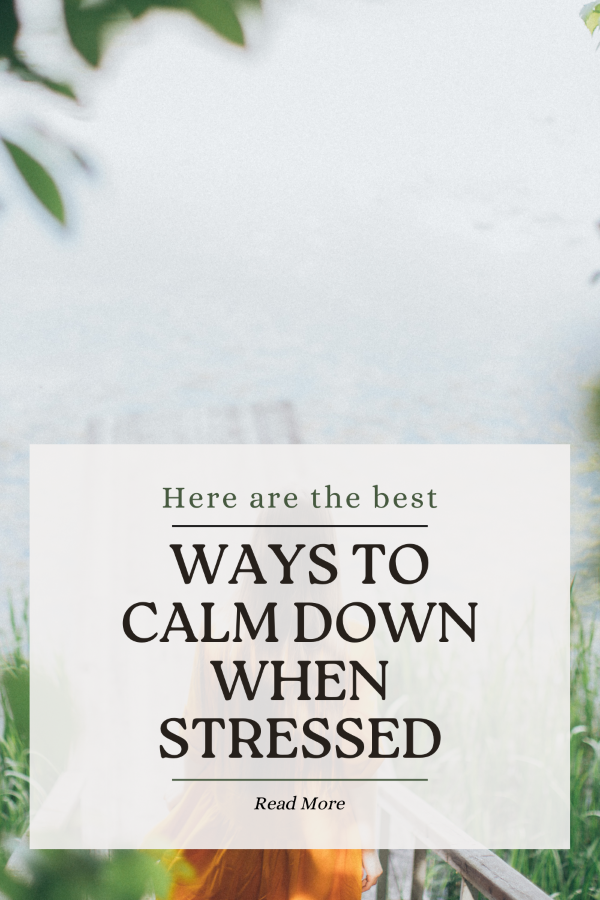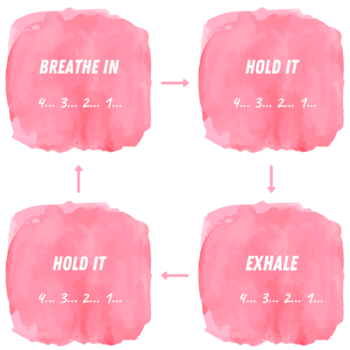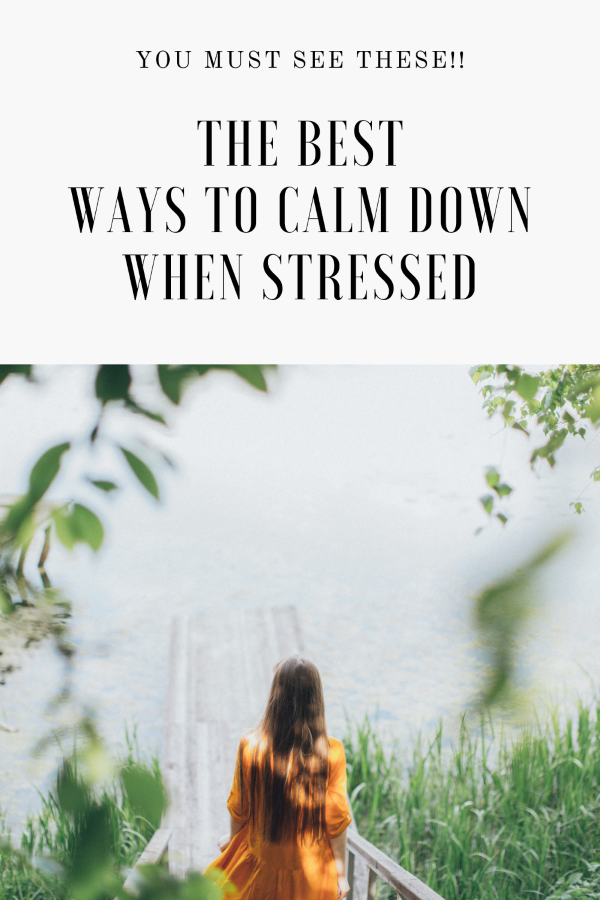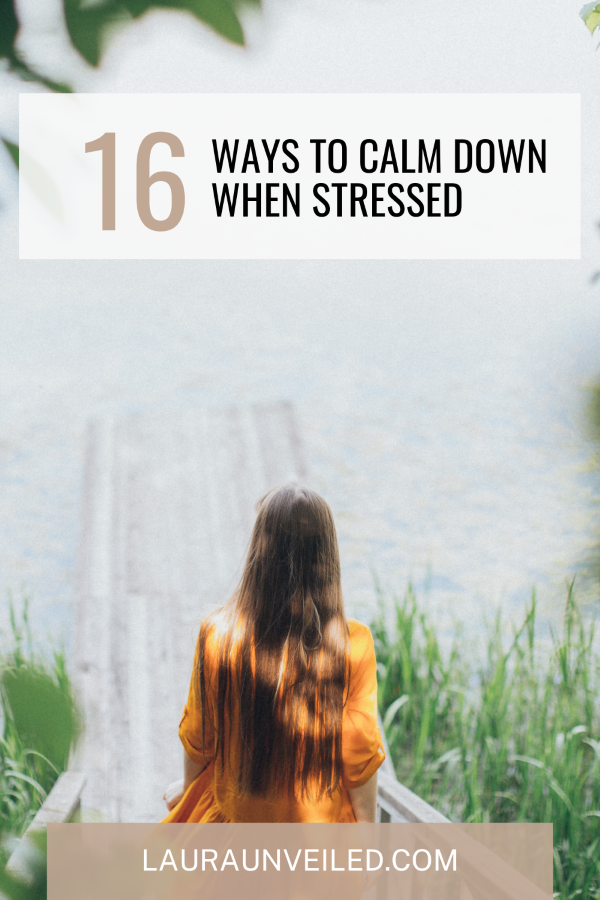How to calm down with these effective techniques
If you’re wondering how to calm down with some good techniques, keep reading!
Everyone is afraid of something. You can be afraid of dogs, public appearances, microbes, or failing; the list is endless.
Having a little fear is good. Having a little fear prevents us from jumping in front of a driving car or jumping down from a very high building. Fear can literally keep us alive.
Problems begin when fear begins to disrupt your life and prevent you from doing things that are important to you.
When you’re affected by such fears, it often has unintended negative consequences and can affect your relationships, academic success, or future plans.
There is no one-size-fits-all solution that will show you how to lower anxiety and stress, so decide what you want to change and develop new habits through exercises and techniques for stress relief.
Anxiety doesn’t occur overnight, and it also doesn’t disappear overnight.
However, with practice and dedication, you can start to make small changes over time, which can make life seem more enjoyable.
You may have noticed that when you feel anxious about something, your thoughts are everywhere, but here, you’re worried about the past or how things will go wrong in the future.
Being mindful helps you focus on what you’re doing at the moment.
Acceptance strategies help you cope with and even accept uncomfortable situations or emotions that you can’t control or change.
Focusing all your attention on the present moment and accepting the discomfort can help you realize that what you’re trying to escape is not as comprehensive as you thought.

This post may contain affiliate links. That means that if you click on a link and purchase something I recommend, I will receive a small commission at no extra cost to you.
Let’s talk about what I do to calm myself down
1. Find out what triggers your anxiety
Anxiety always has a trigger. A good way to identify triggers for anxiety is to ask yourself a simple question: What happened before you felt anxious?
The trigger doesn’t have to be a specific event (although it may be). It can also be a thought, a physical sensation, or even a behavior.
Be aware that triggers can be both internal and external. An external trigger is something that happens outside of your body, such as a fight with a friend, an exam, or a doctor’s appointment.
The inner trigger can be a personal belief, thought, or physical sensation.
Don’t be tough on yourself. If you slip off track because you have a lot on your plate, just come back to the tasks and techniques for stress management whenever you can and continue where you left off.
Keep practicing these techniques for stress relief, preferably daily. It’s common for a technique not to “work” the first time.
An important thing I realized when I was learning how to lower anxiety and stress is that you need to write down when and how anxiety is triggered. Use the following strategy for that:
1. Keep a list. Make a note of when you feel anxious and what happened just before or during it. No need to get complicated—write down the day, time, and what happened. For example, you can write: “Tuesday, rehearsal, my pulse is racing.”
2. Select a specific time of day to take notes.
3. You can write in coded or abbreviated form. This is helpful if you’re worried that someone else might see what you’ve written. You can write a longer version for yourself later.
4. Look for patterns. Writing things down allows you to notice patterns, such as the time of day, events, or people involved. All these little things help identify the triggers. If you notice that you’re always anxious before lunch, then bang! We have found a trigger.
5. Try to start assessing anxiety on a scale from one to ten. Ten is the worst anxiety in your life; zero is the calmest. Remember, ten is the maximum; there is nothing worse than that.
It’s not an exact science, but it gives you an idea of how you experience anxiety in different situations.
2. Break down the emotions
Then start breaking down your emotions. To get started, choose a recent event that caused you anxiety.
Ask yourself the following questions: What was I thinking at the time? How did I react physically? What did I do?
The questions might seem simple, but don’t be surprised if they turn out to be more complicated than expected. It’s a new way of thinking about anxiety.
When thinking about triggers, thoughts, physical sensations, and behaviors becomes a habit for you, you’ll become more aware of them.
Better awareness equals more opportunities to reduce anxiety. It’s good to do this exercise about once a week.
Over time, you’ll find that it becomes easier to break down feelings and experiences.
Once you have started recording your thoughts, feelings, and behaviors, you can begin to think about why you’re acting the way you do.
Sometimes we get so caught up in the anxiety that it feels like quicksand. We’re desperately trying to get out, but we’re sinking even deeper.
When we try to avoid difficulties, we often create situations that cause even more difficulties—this is how we end up in spirals of anxiety.
Taking the time to think about your behavior helps you understand when and where anxiety is causing problems. After that, you can make a plan for how to break out of this cycle.

3. The difference between stress and anxiety
We need to understand the difference between stress and anxiety.
Some people use the words “stress” and “anxiety” as synonyms, but in reality, they are two different things.
You feel stressed when you’re faced with external pressures that aren’t under your control but that are normal parts of life.
Sources of stress can include an exam, a parents’ fight, a big sports competition, or a friend’s birthday party.
However, anxiety is an emotion that you may feel in response to stress. In other words, it’s a reflection of how well you cope with the stresses of life.
Knowing the difference between stress and anxiety is extremely important to prevent stress from turning into anxiety.
Every time I think about how to lower anxiety and stress, I think about mindfulness.
Psychologists teach people to be mindful through imagination, breathing, meditation, and other exercises.
This skill is acquired over time, just as muscles are trained.
Focusing entirely on the present can be difficult, as it means thinking about what’s going on right now while being in the present.
You may be worried that it won’t work out very well (and the idea itself is a deviation!).
Feeling this way is normal, so the best way to practice being mindful is to have short sessions between everyday chores.
Being consistent and practicing even one minute a day may be enough to get started.
4. Progressive muscle relaxation
Anxiety often manifests as physical exhaustion and muscle tension.
Through tightening and relaxing each muscle group, this exercise helps you become more aware of physical sensations and feel physically more comfortable.
Tighten each muscle group for five to ten seconds. Don’t tense the muscles completely; it can hurt.
Aim for about 75 percent muscle tension, then release the tension and relax for about 15 seconds. Note the difference between tension and relaxation.
1. Sit still and focus on breathing.
2. Tighten the right hand and arm. Hold for 10–15 seconds, and then relax, releasing all tension. Do the same with your left hand and arm. Repeat the whole cycle again.
3. Focus on your arms and shoulders. Stretch your arms in the air and then lower them. Feel the tension in your shoulders while stretching them in the air. Now lower your hands to the sides and relax them for 15 seconds. Repeat.
4. Focus on your shoulders and neck. Raise your shoulders toward your ears and feel the tension. Relax, lower your shoulders, and feel the difference between tension and relaxation before doing it again.
5. Focus on your chin. Tighten it by squeezing it, and feel the tension in the jaw and neck muscles. Relax and let your chin be loose before repeating.
6. Tighten the facial muscles. Wrinkle your nose and forehead, squeeze your eyes, and close them. If it seems a little silly, do it when no one can see you. Hold and relax before repeating. Notice if your face feels more relaxed.
7. Focus on the abdomen. Tighten the lower abdomen by pulling the muscles toward the spine. Now let the tension go and feel your stomach relax and expand. Repeat once.
8. Tighten the muscles in your right leg and foot. Raise your leg and bend your toes toward the ceiling. Relax and put your foot back on the floor to rest. Repeat with your left foot, relax for 15 seconds, and complete the entire cycle again.
You may find it helpful to record yourself reading the instructions out loud. You can even close your eyes while listening to the recording and follow the instructions if that helps you focus (just try not to fall asleep!).
With regular practice, you can start to notice tension in your body more easily, and you can focus on relaxing specific muscles instead of doing the whole cycle.

5. The exercise with five minds
Being mindful can help you reduce anxiety by focusing on the environment around you. This is useful when thoughts and feelings seem chaotic and out of control.
Grounding exercises like this one bring your mind back to the present moment. It doesn’t require a quiet place or a lot of time; just focusing your attention is enough.
This is actually one of the best exercises that shows you how to lower anxiety and stress because it keeps you grounded.
1. Look around and name five things you can see. Try to notice things you wouldn’t normally notice.
2. Name four things you can touch. Focus on objects or surfaces while feeling them with your hand or body.
3. Name three things you can hear in your current location. It could be a ticking clock, a buzzing electrical device, or a passing car. Try to notice the sounds you usually ignore.
4. Name two things you can smell. Odors can be pleasant or unpleasant. Try to notice the smells without rating them.
5. Name one thing you can taste. If there is no suitable thing at hand, then try to notice any taste or feeling in your mouth, or if it is too complicated, name one taste you like instead.
If, after completing this exercise, you’re still controlled by your thoughts or feelings, you can do it again until the strong feelings pass.

6. Color breathing
Breathing exercises are the best exercises that teach you exactly how to calm down. They can help relieve stress, make you feel better, and even lower your blood pressure.
This particular exercise combines breathing and imagination to help you clarify your thoughts.
1. Choose two colors: one that you associate with relaxation (a positive color) and another that you associate with anxiety or just don’t like (a negative color).
For example, blue soothes, while yellow reminds me of a warning tape. I used them in this example, but you can choose the colors that appeal to you.
2. Find a quiet place. Sit or lie down in a comfortable position. Close your eyes and start breathing.
3. Inhale. Imagine that blue (the positive color) fills your lungs. Imagine how this color fills your body with peace. Breathe blue into all parts of your body that seem particularly tense.
4. Exhale. Imagine exhaling yellow (the negative color). This tension and anxious air is sticky and tries to stay in your body, so the best way to get rid of it is with long, slow breaths.
5. Keep imagining. See how the blue air fills your body with peace after inhalation and the yellow air leaves your body after exhalation. Feel the breathing prolong as you continue to exercise, and try to exhale longer than you inhale.
7. Square breathing
This is also among my favorite techniques for stress management to add to your toolbox. As with other techniques for stress relief, this one also helps you to refocus and calm your body when you’re anxious.
- Find a comfortable position.
- Inhale slowly for four seconds.
- Hold your breath for four seconds.
- Exhale slowly for four seconds.
- Hold your breath for four seconds.
- Repeat the cycle four times.

8. How to deal with anger?
When was the last time you felt angry? I’m sure it wasn’t long ago. Feeling angry or irritated is normal. Anger is adaptive.
If you were never angry, you would probably let others trample on you. Anger drives us to stand up for our rights, which can be good.
The problem arises when you’re constantly angry, and it causes you to behave in a way that you’ll later regret.
Anger is normal. It’s neither good nor bad. But the way you behave out of anger can have consequences.
It’s important to understand when acting under the influence of anger is progressive—such as standing up for your own or others’ rights—and when it only causes problems.
“Anger is something I can’t control” is a flattering statement, but it’s irrelevant.
You’re right; feelings can’t be turned on and off, but just because you feel angry doesn’t mean you have to act on that feeling. You are in control of your actions.
9. Find out what triggers your anger
It can be helpful to think about factors that trigger anger so that you can prepare for situations where you may be angry.
You will never know how to calm down if you don’t know what triggers you. What makes you angry?
Finding triggers will help you stop the hate cycle sooner and learn how to deal with it. Think for a few minutes about the things that trigger your anger.
Remember: These don’t have to be actions or events. Words, thoughts, or even physical sensations can also be triggers.
Think of a few times when you felt angry to understand what irritates you.
Ask yourself the following questions: Did I get hurt physically or emotionally? Didn’t my expectations come true? Were my needs unmet?
Was there anything specific in the situation that made me angry, such as someone, a sound, or something I saw?
What did I think or do before I started to feel angry? Was the trigger something from the past and not from the current situation?
It’s important to know your triggers and the thoughts that follow them, because this kind of knowledge will help you identify effective coping techniques.
Remember that feeling angry is normal, but acting on that feeling can be emotionally exhausting and damage your relationships.
Do you know why it’s so difficult not to react when you feel an intense emotion, even if, logically, you know that emotion-driven action may not be the best course of action?
Because emotions tell us that if we don’t react to them right away, they will never go away.
But this is completely wrong. Sometimes emotions may indeed seem like tornadoes, but in reality, they are more like waves coming and going.
They hit you hard, but if you give them time, they will eventually go away themselves. The best way to let complex emotions come and go is to accept them.
Acceptance doesn’t mean that you agree with or give in to emotion; it simply means that you’re aware of its existence.
Denying emotions or refusing to acknowledge their existence can backfire and be more painful.
At the same time, dealing with complex emotions helps you overcome them more quickly, without the long-term side effects of avoiding them.
When you’re in a whirlwind of intense negative emotions, it’s sometimes hard to know what to do.

10. Practice self-awareness
If you’re wondering how to lower anxiety and stress or get rid of anger, try to incorporate more self-awareness into your daily life.
If you’re angry, a little self-awareness can help you a lot. Anger often encourages you to act or react quickly.
The following strategy allows you to slow down and think about the consequences before taking action. When you notice that you’re angry, write down the answers to the following questions:
Why am I angry? What am I thinking about? How do I feel in my body? What do I want to do with this emotion?
What would be the consequences of behaving the way I wanted to? What would happen if I did that? Are there alternatives to try instead?
Write down a few alternatives. What would be the consequences of alternative activities? Think about them.
Based on the results of the analysis, make a choice. Good alternatives usually have better consequences.
Acting against instinct is often a good alternative. If you want to lash out and shout, you can speak in a calm voice instead, go for a walk, or even apologize.
Instead of making the situation worse, it can help ease tensions.
11. How anxiety changes and affects your thoughts
Anxiety changes the way you see the world. The sky may be blue, but if you wear tinted sunglasses, you’ll see it differently than it actually is.
Your thoughts do the same: they take reality, filter it, and sometimes distort the result with emotions such as anxiety or anger.
Your brain is full of noise. Take a moment to pay attention to the thoughts that flow through your mind. What did you notice?
Thoughts can be positive (“Hey, this is a cool exercise”), neutral (“This book is blue”), or negative (“I’ll never understand it”).
Thoughts that appear instinctively or without you even noticing are called automatic thoughts. When automatic thoughts are negative, they can suck you into a toxic cycle.
As I mentioned, no secret tells you exactly how to lower anxiety and stress immediately.
My goal isn’t to change your thoughts but to help you build a relationship with them so that they won’t subdue everything or make you more anxious.
People tend to remember negative thoughts better than neutral or positive ones.
Thoughts like “My shoes are red” or “School starts at 7.20” come and go, but thoughts like “I don’t have any friends” have a lot more power.
When one thought causes you anxiety, you’ll notice it more and try to get rid of it, and if you try to get rid of the idea, it will affect you even worse.
One small example. Think about anything but the pink dancing elephant. It doesn’t matter what it is.
There’s a strong likelihood that you didn’t think about elephants at all before reading this sentence, but now you probably have a bunch of pink elephants dancing in your head.
Every attempt to get rid of a thought that’s spiraling in your head makes your brain think about it more and more.
Remember, negative emotions are like quicksand: the more you struggle, the deeper and faster you sink. The more you try to fight such thoughts, the stronger they’ll become.

12. Set a specific time to worry
Your brain is programmed to use shortcuts. That is normal and healthy. That’s why people are great thinkers and inventors.
But it also means that your mind sometimes tries to combine two things that are not related to each other or to interpret them in a way that is of little help.
Anxious thoughts try to conquer all your thoughts. Sometimes it seems that the moment you have overcome one concern, the next is already waiting.
When I was trying to Google information about how to calm down, I came across a cool exercise.
Fast forward: this exercise is among my favorite techniques for stress relief. It focuses on postponing worries and sets a time when you can worry about whatever you want.
You may find that it reduces your general anxiety and helps you regain control of your life.
1. Choose a ten-minute time to become your “worry time.”
2. If the concern hits you during the day outside of the worry time, write down the problem or situation and the potential triggers as well. Since it’s not the “right” time to worry, refocus entirely on what you were doing.
3. When worry time arrives, take out the list and dig into it. Think about your worries as much as you can. This is not a time for solutions.
4. If you still find yourself worrying about the same things after the worry time, write them down and think about them during the next day’s worry time.
It is not a good idea to plan this worrying time just before bedtime, as anxiety can prevent you from falling asleep.
Find time for it during the daytime. If you think you need more time to focus on your worries, you can try setting up two daily worry times, such as one in the morning and one in the afternoon.
13. Sing it out
You may have a particularly strong, nagging thought that you can’t immediately shake off.
An inner critic can constantly belittle you with thoughts like “You’re so stupid” or “No one wants to be your friend.”
The following technique is among some fun techniques for stress management that help you understand thoughts for what they really are: often silly, meaningless words!
- Identify the idea that is bothering you.
- Sing it in some familiar way, such as “Old MacDonald Had a Farm” or “Happy Birthday to You.” Instead of singing, you can try to say your thoughts in a cartoon voice.
- Notice whether repeating the thought so many times will help you reduce the anxiety it causes.

14. Exposure therapy
Exposure therapy will certainly teach you how to calm down. Anxiety makes you avoid important situations out of fear.
Exposure therapy is a technique designed to help you face your fears with a series of steps.
Facing your fears can teach you that the thing you’re afraid of is not as dangerous as it seems and that you can cope with even the most unpleasant situations.
Many studies confirm that exposure therapy is the most effective way to treat a variety of anxiety problems, especially phobias, obsessive-compulsive disorder, and panic attacks.
Exposure therapy is like entering a cold pool. You have two options: either jump in or gradually let your body into the water one centimeter at a time, wetting the toe first, then the ankle, and so on.
Either way, you’ll end up getting wet.
Both ways are uncomfortable (the water is cold!), but your body adjusts to the temperature and gets used to it.
There is no magic button to get you into the pool or heat the water. You need to feel some discomfort.
If you’re afraid of heights, exposure therapy may consist of staying on the second-floor balcony for a while, then moving on to the third-floor balcony, and, as you feel comfortable, staying on higher and higher floors.
Know that the more you do something, the easier it will be.
Sometimes you can use your imagination as well. In such situations (called “imaginal exposure”), you can imagine going to high places instead of actually going there.
This can be useful if you don’t have the opportunity to enter any tall buildings or if you’re too nervous to get to the real thing right away.
It’s important to know that fear doesn’t go away overnight. Exposure therapy sometimes works very quickly, but it can take several sessions to see progress, and it’s often hard work.
Just remember that facing something you’ve avoided for a long time is an achievement in itself.
15. The fear-ladder
It’s best to face fears by starting with the smallest step possible. You can divide fear into a so-called “fear ladder.” If you avoid the things you want or need to do, this is a good way to confront them.
The more specifically you can identify your fear, the easier it will be to come up with exposure strategies. This is how the fear ladder works:
1. Think about the fear you want to overcome. Focus on a situation where avoiding it has negatively affected your life. It should be something specific.
For example: “I want to drive my car alone.” Obviously, life is quite complicated if you avoid driving alone all the time, so overcoming this fear would probably make your life easier.
2. Set a specific goal. Be very clear about the purpose. For example: “I’m driving to my friend’s house all by myself.” When setting a goal, think not only about what you want to do but also when (next week in the month?) and how much or how often you want to do that.
3. Divide the goal into four or more steps. These goals should depend on each other to help you achieve your goal.
Give everything a difficulty level from zero to ten, so that ten is the most difficult and causes the most anxiety, and zero does not cause any anxiety at all. The last step should be the same specific goal you set at the beginning.
4. The stages of the driving example may be the following:
- Sit in the driver’s seat with the engine running. (3/10)
- Drive alone out of the driveway and around the block. (6/10)
- Drive alone for several blocks and back. (8/10)
- Drive alone all the way to your friend’s house. (10/10)
Try to be realistic in your assessments and relate them to each other. If the long distance is 10, then driving out of the driveway is probably not a 10.
5. Try it! Anxiety during exposure training is normal, but this anxiety isn’t dangerous. Start the list with the least disturbing activities and see what happens. If it seems too difficult, brainstorm to find other, easier steps.
If you manage, be proud of your achievement. Give yourself a small reward before moving on to the next stage. Feel proud to have taken the first step in trying to reduce anxiety in your life.

16. Visualize
Let’s talk about visualizing. Think about how much mental energy you have wasted on living with anxiety.
If you’re afraid to fly, you’ve probably spent a lot of time imagining what could go wrong while flying.
On the other hand, how much time have you spent thinking about what would happen if your anxiety was effectively controlled? Visualizations can help you imagine a positive outcome.
1. Think about a specific anxious situation you’re facing, such as being home alone, talking to a new classmate, taking an exam, or going to the doctor.
2. Take a few minutes to write down what a successful outcome would be. Be specific and use all your senses.
What would success look like? How would it feel in your body? What sounds do you hear? What would others say to you, or what would you say to yourself? And remember, you’re still you, so your goal should be achievable.
3. When you’ve been thinking about the event for a while, lie down comfortably. Close your eyes and pay attention to your breathing. Take deep breaths in and out, and watch each inhalation and exhalation.
4. Now pay attention to the imagined success scenario. Imagine completing the task you wrote about. Imagine what you see, sounds, and physical sensations. Imagine what you’d say or do.
Practice this technique before facing an anxious situation. If you’re actually in an anxious situation, use exposure techniques and techniques for stress management to reach the finish line.
Before you leave, make sure to check out my blog post about amazing techniques for calming down your mind and the best self-soothing techniques to try this year.
DON’T FORGET TO PIN!






